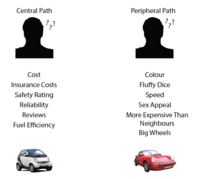
Photo from wikipedia
Time-varying autoregressive (TVAR) models are widely used for modeling of non-stationary signals. Unfortunately, online joint adaptation of both states and parameters in these models remains a challenge. In this paper,… Click to show full abstract
Time-varying autoregressive (TVAR) models are widely used for modeling of non-stationary signals. Unfortunately, online joint adaptation of both states and parameters in these models remains a challenge. In this paper, we represent the TVAR model by a factor graph and solve the inference problem by automated message passing-based inference for states and parameters. We derive structured variational update rules for a composite “AR node” with probabilistic observations that can be used as a plug-in module in hierarchical models, for example, to model the time-varying behavior of the hyper-parameters of a time-varying AR model. Our method includes tracking of variational free energy (FE) as a Bayesian measure of TVAR model performance. The proposed methods are verified on a synthetic data set and validated on real-world data from temperature modeling and speech enhancement tasks.
Journal Title: Entropy
Year Published: 2021
Link to full text (if available)
Share on Social Media: Sign Up to like & get
recommendations!